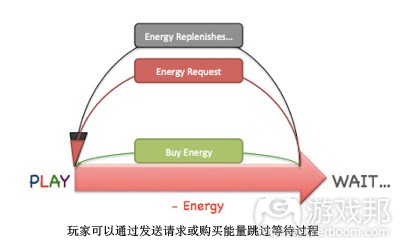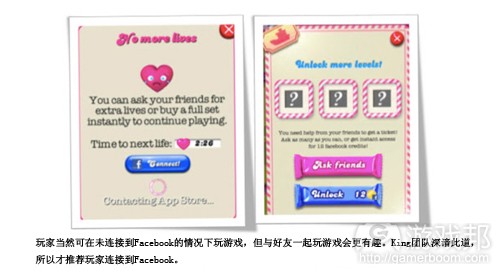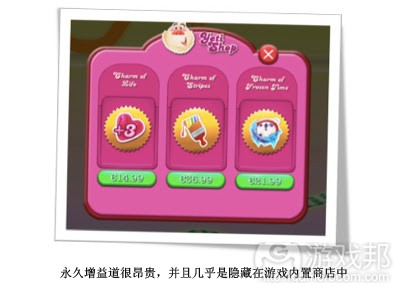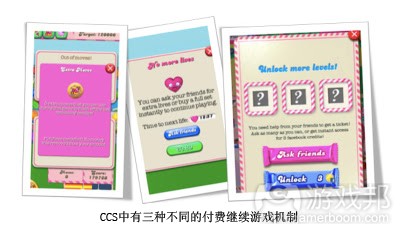解析《Candy Crush Saga》游戏盈利设计
作者:Lähettänyt Michail Katkoff
来自King公司的《Candy Crush Saga》(以下简单称CCS)由于一些关键元素而高居应用收益榜单前列。该游戏极具易用性,支持玩家在线和离线玩游戏。它的准入门槛较低,并充分利用了病毒传播功能。其图像和声音也颇为与众不同,极具吸引力。其中基于进程的地图,也确保玩家可以在离开游戏多时之后追踪原来的游戏进展。那么你如何才能打败这款游戏?
核心循环
CCS有一个基于能量的经济系统。玩家每次失败或重新开始一个关卡时,都要消耗一颗红心(能量)。现在玩家用光能量了,他们就只有三个选择:等待、请求帮助或购买。玩家可通过计时器机制(即等待充满能量)以及病毒传播机制重返游戏。
CCS的病毒机制包含两个主要层面,即合作和竞争。玩家可以向对方发送红心,帮助彼此绕过付费墙获得游戏进展;而竞争则表现在基于进展的地图,以及基于关卡的排行榜。
乍一看,CCS可能只是用上了一切可能传播消息的渠道。但实际上,其病毒传播方式经过了彻底的精心设计。首先,病毒传播是其核心循环的关键环节,并且作用与付费货币一样。其次,CCS的病毒传播几乎采用了一种极为鼓励分享和点击的方式。第三,CCS十分出色地将合作元素整合到游戏中,让玩家看到自己所帮助的对象如何顺利完成任务。换句话说,CCS是通过合作来创造竞争感。
鼓励分享的条件
乐于助人:它提供奖励,具有激励性,若另一玩家作出回应则可以得到奖励——请求好友帮助解琐进程就是一个绝佳例子。
快乐主义:它允许鱙家炫耀个人成就和创意。
社交义务:通过互惠原则,或者社交动作(例如合作关系或投资)而寻求他人的付出。
利他主义:它通过让玩家免费给予他人一些东西或者帮助而得到自我满足感(例如“Kack帮助Timur建设大富翁城市”)。
鼓励点击的条件
奖励:承诺即时奖励或进程。
刺激:该条件会通过竞争(“复仇”)、同情(“拯救大熊猫”)或者好奇心(“Jack刚赢了100万美元”)来回应游戏。
社交义务:它因互惠动作(例如,赠礼,请求帮助),或其代表的社交纽带/动作(“Linda为你投资了”,“Jim的城市有一个新的建筑,向提供帮助的好心人答谢!”)而呈现说服力。
竞争条件
*好友互访对方的游戏区域(可以通过任务或奖励而设置访问功能)
*积分排行榜(Jason前面还有多少关卡)
*吹牛功能(“我已经完成了X的建设”)
*告知玩家游戏进程的请求(“请帮我打败Y敌人”)
低售价和高盈利
CCS中没有高级货币。玩家不可购买大量资源,玩家最多可支付的单笔交易额为39.99美元,并且这笔交易只能执行一次。事实上,该游戏中的交易包括购买额外行动和红心,这两者售价都是0.99美元。尽管存在这些限制,CCS仍能通过三种不同的购买内容而有效创收:永久增益道具、易消耗增益道具,以及付费继续游戏。
永久增益道具
玩家可购买三种不同的永久增益道具。这些增益道具通过游戏内置商店出售,但游戏中几乎没有出现推广这些增益道具的内容。在我看来,这可能意味着这些道具销售情况可能不是太好,或者它们对用户留存率和游戏收益造成了消极影响(对于购买了永久增益道具的玩家来说,这样游戏就太容易了)。
易消耗的增益道具
在玩家开始关卡之前,他们可以购买三种不同的易消耗增益道具,这有助于他们获得一个良好的开端。这些易消耗道具可通过游戏进程来解琐,并且要取决于不同关卡(例如,基于时间的关卡中的增益道具就不同于基于行动的关卡道具)。
易消耗道具是通过介绍机制而呈现在玩家面前。解琐一个新提升道具时,玩家可以免费进行测试,并学习如何使用该道具,了解该道具如何帮助自己完成关卡。
付费继续游戏
CCS有相当一部分收益来自真正的微交易模式,即玩家购买红心、额外行动和解琐新关卡。游戏进程以及设置良好的付费预期点创造了这些购买需求。
完善和简化
那么你该如何打败CCS?首先要足够简化。与Zynga的《Bubble Safari》等类似游戏相比,CCS更为简单,不含XP也没有玩家等级。也没有软货币和高级货币。游戏中的商店并不推广产品,实际上也只出售三种道具。我想正是这种简单性促使玩家体验游戏并掏钱消费。
其次,你得支持一些小额售价点,真正促使玩家掏出1美元。根据我个人经历,我发现玩家如果看到游戏内置商店中有售价较高的IAP时,他们一般都会更为谨慎,生怕一不小心点错按钮,会让自己损失20美元。但这些玩家也更容易支持1-3美元的道具,也更可能多次连续购买此类IAP。
在我看来,CCS的成功来自强大的病毒传播整合(合作&竞争),对游戏进程的重视(付费继续游戏),基于数量的定价(易消耗品极为平价)以及出色的玩法外加精妙的图像。显然,要战胜这样一款游戏实非易事。(本文为游戏邦/gamerboom.com编译,拒绝任何不保留版权的转载,如需转载请联系:游戏邦)
Beating Candy Crush Saga
Lähettänyt Michail Katkoff
Candy Crush Saga from King rules the top grossing charts because of several key elements. It’s extremely accessibile, as you can play the game both on and offline. It has a low entry barrier and the game takes full use of virality. The graphics and the sounds of the game are both distinctive and weirdly appealing. Not to mention the map based progress, which ensures relevancy for players who start the game even year apart. So how can you beat this game?
The Core Loop
CCS has an energy based economy. Players consume one Heart (energy) each time they fail or restart a level. Now once players are out of Hearts they are left with three options: wait, request or buy. Players are driven back to the game via timer mechanics (wait for Energy to recharge) and a cocktail of virality, which I’ll break down in the virality part of this text.
Overflow of Meaningful Virality
CCS was initially developed as a Facebook game and even though it has been fully rewritten for mobile the origin of the game shows – especially in the easiness of sharing and requesting. In fact it seems that most players let CCS post for them on Facebook.CCS’s virality consists of two main aspects, which are collaboration and competition. Players collaborate by sending each other Hearts and by helping each other to progress over pay walls. Competition on the other hand is driven by map based progress screen and level based leaderboard.
At first glance CCS might just seem as an app that does all the possible things to spam. But in fact their approach to virality is very thorough and well thought. First of all virality is a key part of core loop and acts in a way as a premium currency. Secondly CCS:s virality is (almost) always shareworthy and clickworthy. Thirdly the way CCS has integrated collaboration into the game is beautiful as it is in the area of the game where the helping player is compelled to see how well the helped player is doing. In other words CCS creates competition via collaboration.
Shareworthy conditions
Instrumental: The feed is a result of rewards, or, it is incentivized i.e. it signals a prospect of rewards in case another player responds – asking help for progress unlocks in CCS is a great
example.
Hedonistic: The feed allows to show off personal achievements and/or creativity
Socially obligating: The feed seeks others’ commitment via the promise of mutual benefits, or via a social gesture, e.g. a partnership or investment
Altruistic: The feed provides an increased feeling of self- worth while giving something out for free or helping (‘Jack helped Timur to build in Millionaire City!’)
Clickworthy conditions
Rewarding: Responding to the feed is incentivized; promises instant rewards or progression <!
Provocative: The feed provokes to return back to the game through competition (‘Have revenge’), empathy (‘save the panda’), or curiosity (‘Jack just earned a million dollars’)
Socially obligating: The feed is persuasive through a reciprocal gesture (e.g. gifting, cry for
help), or a social tie/ gesture that it represents (‘Linda made an investment on You’; ‘Jim has
new buildings in his/her city. Thanks to those who helped!’)
Competition encouraged by:
Friends visiting each others game areas (visitations can be driven by quests or by rewarding player for visits)
Leaderboard (How many levels ahead Jason is)
Bragging feeds (“I’ve completed Building X”)
Requests that tell how far the player is in the game (“Help me defeat Enemy Y”) Small Price Points and Huge Revenue
There’s no premium currency in CCS. Players can’t buy bundles of resources. Most expensive purchase player can make is $39.99 and this purchase can only be made once. In fact the bulk of the purchases in the game consist of buying extra moves and hearts, which both cost $0.99. Yet despite all of these limitations CCS monetizes extremely well using effectively three different purchase categories: permanent boosters, consumable boosters and pay-to-continue.
Permanent Booster
There are three different permanent boosters player can buy. These boosters are sold in the in- game shop and there’s literally no promotion inside the game to pushing these boosters. To me this is a sign that these booster don’t sell too well and/or they mess up retention and monetization for players who have bought them (game might feel too easy for players who purchase a permanent booster).
Consumable Boosters
Before player starts level they can purchase three different kind of consumable boosters, which help by giving a head start. These consumable boosters are unlocked by progress and they vary based on the level (for example in time based levels the boosters are different than with move based levels).
Consumable boosters are pushed to player via introduction mechanics. When a new power-up is unlocked player gets to test it for free thus learning to use the power-up and realizing how the power-up can help to pass a level.
Pay-to-Continue
Bulk of revenue in CCS comes from true micro-transactions as players buy Hearts, extra moves and unlock new levels. What creates the strong demand for these purchases is the need to progress and well placed prime-to-spend points.
Perfect and Simplify
So how to beat CCS? Well first you have to simplify. In comparison to similar titles, such as Zynga’s Bubble Safari, CCS is a lot more simpler. There are no XP nor player levels. There’s no soft currency nor premium currency. The in-game shop isn’t promoted and actually has only three items in it. And I think this simplicity is what draws players to play and pay.Secondly you have to embrace small price points and really push your players to spend that one dollar. Personally I’ve noticed that when players who typically avoid IAPs see large packages in the in- game shop they become very cautious as if tapping on a wrong button will strip them off $20. But when these same players are surrounded by $1-$3 packages they feel comfortable and actually make several purchases in a row (behaving just like they do when in the AppStore).In my opinion the success of CCS is based on great virality integrations (collaborate & compete), emphasis on progress (pay-to-continue), volume based pricing (very cheap one-off consumables) and naturally great gameplay accompanied by awesome graphics. Can you beat that? Well, it’s not going to be easy.(source:deconstructoroffun)















































 闽公网安备35020302001549号
闽公网安备35020302001549号